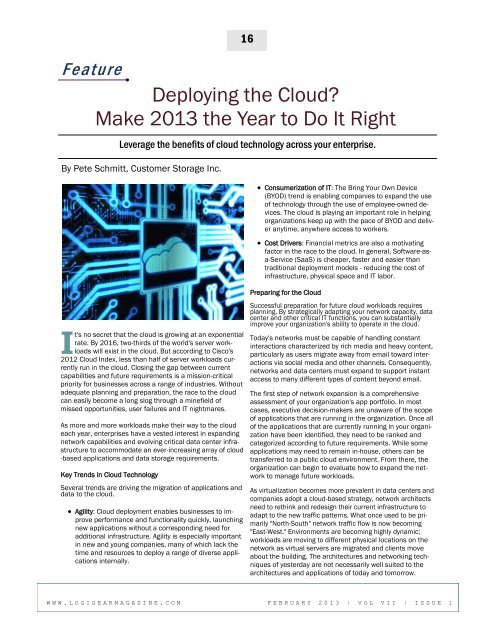FeatureIt's no secret that the cloud is growing at an exponentialrate. By 2016, two-thirds of the world's server workloadswill exist in the cloud. But according to Cisco's2012 Cloud Index, less than half of server workloads currentlyrun in the cloud. Closing the gap between currentcapabilities and future requirements is a mission-criticalpriority for businesses across a range of industries. Withoutadequate planning and preparation, the race to the cloudcan easily become a long slog through a minefield ofmissed opportunities, user failures and IT nightmares.As more and more workloads make their way to the cloudeach year, enterprises have a vested interest in expandingnetwork capabilities and evolving critical data center infrastructureto accommodate an ever-increasing array of cloud-based applications and data storage requirements.Key Trends in Cloud TechnologySeveral trends are driving the migration of applications anddata to the cloud. Agility: Cloud deployment enables businesses to improveperformance and functionality quickly, launchingnew applications without a corresponding need foradditional infrastructure. Agility is especially importantin new and young companies, many of which lack thetime and resources to deploy a range of diverse applicationsinternally.16Deploying the Cloud?Make 2013 the Year to Do It RightLeverage the benefits of cloud technology across your enterprise.By Pete Schmitt, Customer Storage Inc. Consumerization of IT: The Bring Your Own Device(BYOD) trend is enabling companies to expand the useof technology through the use of employee-owned devices.The cloud is playing an important role in helpingorganizations keep up with the pace of BYOD and deliveranytime, anywhere access to workers. Cost Drivers: Financial metrics are also a motivatingfactor in the race to the cloud. In general, Software-asa-Service(SaaS) is cheaper, faster and easier thantraditional deployment models - reducing the cost ofinfrastructure, physical space and IT labor.Preparing for the CloudSuccessful preparation for future cloud workloads requiresplanning. By strategically adapting your network capacity, datacenter and other critical IT functions, you can substantiallyimprove your organization's ability to operate in the cloud.Today's networks must be capable of handling constantinteractions characterized by rich media and heavy content,particularly as users migrate away from email toward interactionsvia social media and other channels. Consequently,networks and data centers must expand to support instantaccess to many different types of content beyond email.The first step of network expansion is a comprehensiveassessment of your organization's app portfolio. In mostcases, executive decision-makers are unaware of the scopeof applications that are running in the organization. Once allof the applications that are currently running in your organizationhave been identified, they need to be ranked andcategorized according to future requirements. While someapplications may need to remain in-house, others can betransferred to a public cloud environment. From there, theorganization can begin to evaluate how to expand the networkto manage future workloads.As virtualization becomes more prevalent in data centers andcompanies adopt a cloud-based strategy, network architectsneed to rethink and redesign their current infrastructure toadapt to the new traffic patterns. What once used to be primarily"North-South" network traffic flow is now becoming"East-West." Environments are becoming highly dynamic;workloads are moving to different physical locations on thenetwork as virtual servers are migrated and clients moveabout the building. The architectures and networking techniquesof yesterday are not necessarily well suited to thearchitectures and applications of today and tomorrow.W W W . L O G I G E A R M A G A Z I N E . C O M F E B R U A R Y 2 0 1 3 ǀ V O L V I I ǀ I S S U E 1
17A thorough understanding of networking, the infrastructurethat is its foundation, and its relationship to applications isnecessary when architecting a data center network that iscapable of supporting and adapting to future challengesthat arise as a result of virtualization and cloud computing.The solution must address all aspects of application delivery- security, availability, performance, and visibility - whileexhibiting the qualities and characteristics that define cloudarchitectures including affordability and elastic scalability.The data must be protected against attacks, intrusions,breaches, and leaks and categorized based on its importanceand network resource needs with Quality-of-Service (QoS) capabilities.Storage and Backup is another key to preparing for cloudmigration. Security is a top-of-mind issue in the cloud. Althoughcloud deployments offer real benefits, your organizationneeds to know that sensitive data will remain secure.The process for preparing for cloud-based data storage andbackup mirrors the process for evaluating network expansionrequirements. Starting with an assessment of currentdata sources and storage routines, the organization needsto evaluate what types of data can eventually either integratewith or be completely transferred to the cloud.Equipped with this information, the organization can beginto identify the technology gaps that need to be addressed tomeet future cloud storage and backup requirements.Purpose-built appliances provide fast backup and restoreand deliver local-like performance while using the cloud forsecure off-site storage. This helps avoid the need to provisionand manage a secondary site for Disaster Recovery(DR) or long-term storage. This can dramatically reducecapital spending, streamline IT infrastructure, and enablepayback periods that are measured in months, not years.Appliances can be combined with existing data protectionapplications and private or public clouds, creating a lowcost, highly scalable storage tier for old or infrequently accesseddata. Appliances also allow organizations of all sizesto modernize their data protection architecture, eliminatetape, improve scalability, and improve Disaster Recoveryreadiness. Cloud storage allows organizations to leverage apay-for-use pricing model and anywhere availability.Increased virtualization will alleviate some of the cloud migrationchallenges upfront. Cloud technology enables organizationsto move servers to the cloud and back in an integratedand strategic manner. In fact, the use of virtualizationcan also play an important role in preparing the organization'sculture and stakeholders for future cloud deployments.By increasing the use of virtualization now, you canencourage greater acceptance of the cloud across yourenterprise. In essence, virtualization can serve as a bridgeto the cloud.It is the key technology that enables the cloud, and withoutit there is no cloud. The ability to separate the OS and applicationfrom the hardware allows it to be the foundationrequired for on-demand cloud services. The encapsulationoffered in virtualization and the mobility that enables a livevirtual machine to be moved with no downtime for the applicationis what the cloud is built on. If you look at virtualization/ cloud computing as a whole, it really is not about aproduct, but a journey. Companies initially enter the worldof virtualization because they just can't keep up with theincreased scale, complexity, and management requirementswhile maintaining their current traditional infrastructure.This leads them to the first step in the virtualization journey,which is to consolidate their resources/infrastructure to getbetter utilization of their servers and to reduce their energycost. Higher levels of abstraction allow companies to takeadvantage of the intelligence built into the virtualizationsoftware. Intelligent software allows High Availability (HA)and Replication, load balancing, pooled resources, selfautomation/orchestration,service definitions or serviceprofiles, templates, policies, self-service portal, service catalog(s),security and identity management, system monitoring/management,capacity planning, billing and chargeback,and licensing.It's important to understand that the ability to handle futurecloud-based workloads will present different challenges andconcerns for the stakeholders in your organization; usersare motivated by ease-of-use and increased access to applicationsand data, CIOs are focused on control, ownershipand security and CFOs are primarily concerned about thecost savings, rate of return and OpEx versus CapEx, etc. Bythoughtfully and strategically preparing for future cloudopportunities, your organization can address these concernsand fully leverage the benefits of cloud technologyacross the enterprise. ■About PetePete Schmitt is Vice President of Engineering at CustomerStorage Inc. Since 2002, cStor has helped companiesstrategize, create, and implement best in class data centersolutions that address business needs. cStor’s proven capabilitieswith key data center technologies provides clientswith a fresh perspective, the ability to collaborate with recognizeddata center experts, and the confidence that goalswill be met.W W W . L O G I G E A R M A G A Z I N E . C O M F E B R U A R Y 2 0 1 3 ǀ V O L V I I ǀ I S S U E 1





